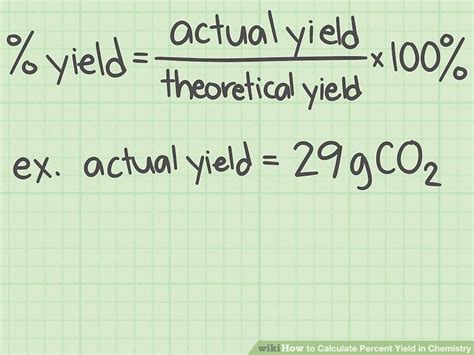How To Calculate Percentage Yield A Level Chemistry
Ronan Farrow
Feb 24, 2025 · 3 min read

Table of Contents
How to Calculate Percentage Yield: A Level Chemistry
Percentage yield is a crucial concept in A Level Chemistry, reflecting the efficiency of a chemical reaction. It tells us how much of the desired product we actually obtained compared to the theoretical maximum. Mastering its calculation is essential for success in your exams. This guide will break down the process step-by-step, providing you with a clear understanding and the confidence to tackle any percentage yield problem.
Understanding the Components
Before we dive into the calculation, let's define the key terms:
-
Actual Yield: This is the actual mass (in grams) of the product you obtained from your experiment. This is the amount you actually managed to isolate and measure in the lab.
-
Theoretical Yield: This is the maximum possible mass (in grams) of the product that could be produced, based on stoichiometric calculations from the balanced chemical equation and the limiting reactant. It's the ideal outcome assuming perfect reaction conditions.
The Formula
The formula for calculating percentage yield is straightforward:
Percentage Yield = (Actual Yield / Theoretical Yield) x 100%
Step-by-Step Calculation
Let's walk through a typical example:
Problem: You are reacting 10.0g of reactant A with excess reactant B. The balanced chemical equation is: A + B → C. The molar mass of A is 50 g/mol, and the molar mass of C is 100 g/mol. After the reaction, you isolate 15.0g of product C. Calculate the percentage yield.
Step 1: Calculate the moles of the limiting reactant (A).
- Moles = mass / molar mass
- Moles of A = 10.0g / 50 g/mol = 0.2 mol
Step 2: Determine the theoretical moles of product (C) based on stoichiometry.
From the balanced equation, 1 mole of A produces 1 mole of C. Therefore, 0.2 moles of A will produce 0.2 moles of C.
Step 3: Calculate the theoretical yield of product (C) in grams.
- Mass = moles x molar mass
- Theoretical Yield of C = 0.2 mol x 100 g/mol = 20.0g
Step 4: Calculate the percentage yield.
- Percentage Yield = (Actual Yield / Theoretical Yield) x 100%
- Percentage Yield = (15.0g / 20.0g) x 100% = 75%
Therefore, the percentage yield of the reaction is 75%.
Factors Affecting Percentage Yield
Several factors can influence percentage yield, including:
- Incomplete Reactions: Not all reactants might have reacted completely.
- Side Reactions: Unwanted reactions can consume reactants and reduce the yield of the desired product.
- Loss of Product During Purification: Some product might be lost during separation and purification techniques.
- Equilibrium: In reversible reactions, the equilibrium position might not favor the formation of the desired product.
Improving Percentage Yield
Understanding the factors that influence percentage yield allows for improvements in experimental design and execution. Techniques like optimizing reaction conditions, using purification methods effectively, and careful handling of reagents can significantly increase the percentage yield.
Conclusion
Calculating percentage yield is a fundamental skill in A Level Chemistry. By understanding the formula and the factors influencing it, you can accurately assess the efficiency of chemical reactions and improve your experimental techniques. Remember to practice with various examples to build your confidence and mastery of this essential concept.
Featured Posts
Also read the following articles
| Article Title | Date |
|---|---|
| How To Find Area Of Triangle With Just Side Lengths | Feb 24, 2025 |
| How To Reset Iphone Data | Feb 24, 2025 |
| How To Negotiate Salary Teacher | Feb 24, 2025 |
| How To Open Bios Dell | Feb 24, 2025 |
| How To Lose Face Fat But Gain Weight | Feb 24, 2025 |
Latest Posts
Thank you for visiting our website which covers about How To Calculate Percentage Yield A Level Chemistry . We hope the information provided has been useful to you. Feel free to contact us if you have any questions or need further assistance. See you next time and don't miss to bookmark.
